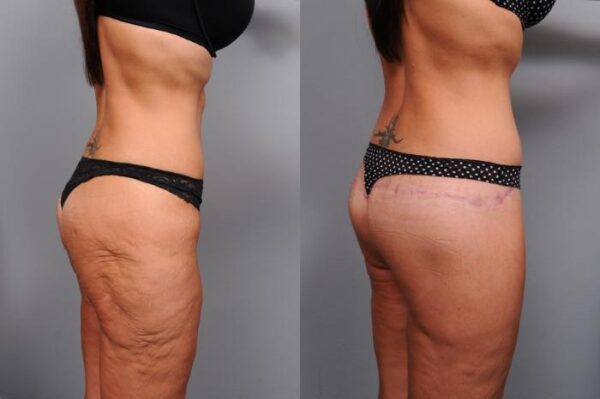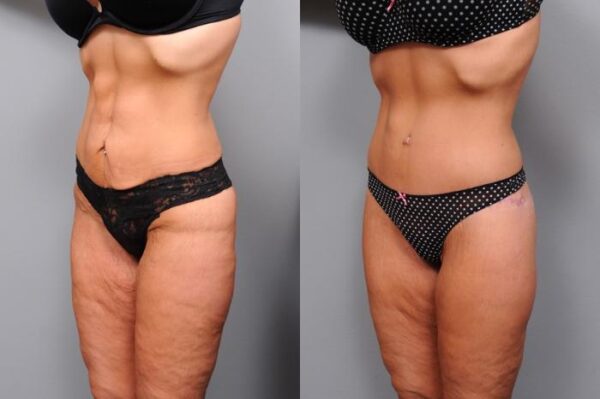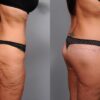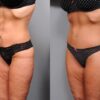Description
Familiarity with treatment
A lower body lift, also known as a belt lipectomy, is a surgical procedure that targets the lower abdomen, hips, buttocks, and thighs. It is designed to remove excess skin and fat in these areas and tighten the remaining skin to create a more contoured and toned lower body appearance.
During a lower body lift, the surgeon will make an incision around the waistline, typically extending from the lower abdomen to the back. This allows access to the targeted areas of the lower body. The excess skin and fat are then removed, and the remaining skin is lifted and tightened. The incision is strategically placed to be hidden within the natural creases of the body or concealed by clothing.
The benefits of a lower body lift include:
- Improved lower body contour: A lower body lift can address sagging skin, excess fat, and cellulite in the lower abdomen, hips, buttocks, and thighs. By removing the excess tissue and tightening the remaining skin, it can create a more sculpted and toned appearance.
- Enhanced body proportions: Excess skin and fat in the lower body can create an imbalance in body proportions. A lower body lift helps to restore balance and harmony to the overall body shape, resulting in improved body proportions.
- Reduction of skin laxity: Significant weight loss, pregnancy, or aging can lead to loose and sagging skin in the lower body. A lower body lift can effectively remove the excess skin and tighten the remaining skin, reducing skin laxity and improving skin elasticity.
- Improved self-confidence: Excess skin and fat in the lower body can be a source of self-consciousness for many individuals. By improving the appearance of the lower body, a lower body lift can help boost self-confidence and improve body image.
Who is it suitable for?
A lower body lift is suitable for individuals who have excess skin and fat in the lower abdomen, hips, buttocks, and thighs. It is commonly performed on individuals who have experienced significant weight loss, either through bariatric surgery or lifestyle changes, and have loose, sagging skin as a result.
Suitable candidates for a lower body lift typically exhibit the following characteristics:
- Excess skin and fat: Candidates should have a significant amount of excess skin and fat in the lower body, particularly in the lower abdomen, hips, buttocks, and thighs. This excess tissue should be resistant to diet and exercise efforts.
- Stable weight: It is important for candidates to have achieved a stable weight before undergoing a lower body lift. Significant fluctuations in weight can affect the long-term results of the procedure.
- Good overall health: Candidates should be in good overall health and free from any medical conditions that could increase the risks associated with surgery and recovery.
- Realistic expectations: It is important for candidates to have realistic expectations about the outcomes of a lower body lift. While the procedure can significantly improve the appearance of the lower body, it is important to understand that it will leave scars and that individual results may vary.
- Commitment to a healthy lifestyle: Candidates should be committed to maintaining a healthy lifestyle, including regular exercise and a balanced diet, to ensure the longevity of the results achieved through a lower body lift.
Who is it not suitable for?
A lower body lift may not be suitable for everyone. There are certain factors and conditions that may make an individual ineligible for the procedure. Some reasons why a lower body lift may not be suitable include:
- Insufficient excess skin and fat: A lower body lift is designed to address significant amounts of excess skin and fat in the lower body. If an individual has minimal excess tissue or if the concerns are limited to specific areas, alternative procedures may be more appropriate.
- Unstable weight: It is important for candidates to have achieved a stable weight before undergoing a lower body lift. Significant fluctuations in weight can affect the long-term results of the procedure. Candidates should be committed to maintaining a stable weight after the surgery.
- Poor overall health: Individuals with certain medical conditions or health issues may not be suitable candidates for a lower body lift. These conditions may include uncontrolled diabetes, heart disease, bleeding disorders, or compromised immune systems. It is important to have a thorough medical evaluation to determine if the surgery is safe.
- Smoking or tobacco use: Smoking and tobacco use can increase the risk of complications during and after surgery. Candidates who smoke or use tobacco products may be advised to quit before undergoing a lower body lift.
- Unrealistic expectations: It is important for candidates to have realistic expectations about the outcomes of a lower body lift. While the procedure can significantly improve the appearance of the lower body, it is important to understand that it will leave scars and that individual results may vary.
- Inability to commit to recovery and aftercare: A lower body lift is a major surgical procedure that requires a significant recovery period. Candidates should be prepared to follow post-operative instructions, including restrictions on physical activity and proper wound care.
Advantages
The advantages of a lower body lift include:
- Improved body contour: A lower body lift can significantly improve the contour and shape of the lower body by removing excess skin and fat. It can help create a more toned and sculpted appearance, enhancing the overall body shape.
- Reduction of sagging skin: Significant weight loss or aging can lead to loose and sagging skin in the lower body. A lower body lift can effectively remove this excess skin, resulting in a smoother and tighter appearance.
- Enhanced self-confidence: Excess skin and fat in the lower body can be a source of self-consciousness and discomfort for many individuals. By improving the appearance of the lower body, a lower body lift can help boost self-confidence and improve body image.
- Improved mobility and comfort: Excess skin in the lower body can cause discomfort and hinder mobility. By removing the excess skin, a lower body lift can improve comfort and make physical activities easier.
- Long-lasting results: The results of a lower body lift are typically long-lasting, especially when combined with a healthy lifestyle that includes regular exercise and a balanced diet. However, it’s important to maintain a stable weight to ensure the longevity of the results.
- Customizable procedure: A lower body lift can be tailored to address the specific concerns and goals of each individual. The surgeon can customize the procedure to target the areas of the lower body that require improvement, ensuring personalized and natural-looking results.
Complications
Like any surgical procedure, a lower body lift carries potential risks and complications. It’s important to be aware of these potential complications and discuss them with your plastic surgeon before undergoing the procedure. Some possible complications of a lower body lift may include:
- Infection: There is a risk of developing an infection at the incision sites. This can usually be treated with antibiotics, but in some cases, additional procedures may be required to drain the infection.
- Bleeding: Excessive bleeding during or after the surgery is a potential complication. Your surgeon will take steps to minimize the risk of bleeding, but it’s important to be aware that it can occur.
- Poor wound healing: Some individuals may experience delayed wound healing or wound separation. This can lead to longer recovery times and may require additional treatments or interventions.
- Scarring: A lower body lift involves incisions, which will result in scars. While efforts are made to place the incisions in discreet locations, the extent and visibility of scarring can vary from person to person.
- Skin irregularities: In some cases, there may be unevenness or contour irregularities in the treated areas. This can include lumps, bumps, or uneven skin texture. Additional procedures may be necessary to address these issues.
- Numbness or changes in sensation: Temporary or permanent changes in sensation, including numbness or altered sensation, may occur in the treated areas. This is usually temporary but can be permanent in rare cases.
- Fluid accumulation: Fluid accumulation, known as seroma, can occur after a lower body lift. This may require drainage through a needle or additional procedures to address.
- Blood clots: There is a risk of developing blood clots, known as deep vein thrombosis (DVT), after any surgical procedure. These clots can be potentially dangerous if they travel to other parts of the body, such as the lungs. Steps are taken to minimize this risk, such as early mobilization and the use of compression garments.
- Anesthesia risks: General anesthesia carries its own set of risks, including allergic reactions, respiratory problems, and adverse reactions to medications. Your anesthesiologist will discuss these risks with you before the surgery.
Preoperative care
Preoperative care is an essential part of preparing for a lower body lift surgery. It involves a series of steps and precautions to ensure that you are in the best possible condition for the procedure and to minimize the risk of complications. Here are some common preoperative care guidelines for a lower body lift:
- Medical evaluation: Before undergoing a lower body lift, you will undergo a thorough medical evaluation. This may include a physical examination, blood tests, and other diagnostic tests to assess your overall health and identify any underlying medical conditions that may affect the surgery or recovery.
- Quit smoking and avoid certain medications: If you smoke, it is strongly recommended to quit smoking several weeks before the surgery. Smoking can impair healing and increase the risk of complications. Additionally, your surgeon will provide a list of medications and supplements to avoid before the surgery, as some medications can increase the risk of bleeding or interfere with anesthesia.
- Adjust medications: If you are taking any prescription medications, your surgeon will advise you on whether to continue or adjust the dosage leading up to the surgery. It is important to follow their instructions carefully.
- Maintain a stable weight: It is important to maintain a stable weight before the surgery. Significant fluctuations in weight can affect the results of the procedure. Your surgeon may provide guidance on maintaining a healthy diet and exercise routine leading up to the surgery.
- Follow preoperative fasting instructions: Your surgeon will provide specific instructions regarding fasting before the surgery. It is important to follow these instructions to ensure your safety during the procedure.
- Arrange for transportation and support: Since a lower body lift is a major surgical procedure, you will need someone to drive you home after the surgery and provide support during the initial recovery period. Make arrangements in advance to have a responsible adult accompany you to and from the surgical facility.
- Prepare your home for recovery: Before the surgery, make sure your home is prepared for your recovery. This may include setting up a comfortable recovery area, stocking up on necessary supplies, and arranging for any assistance you may need during the initial recovery period.
- Follow preoperative instructions: Your surgeon will provide you with specific preoperative instructions, including guidelines on showering, skincare, and avoiding certain foods and beverages. It is important to follow these instructions closely to ensure a smooth and successful surgery.
Postoperative care
Postoperative care is crucial for a successful recovery after a lower body lift surgery. Following your surgeon’s instructions and taking proper care of yourself can help minimize complications, promote healing, and achieve optimal results. Here are some common postoperative care guidelines for a lower body lift:
- Follow wound care instructions: Your surgeon will provide specific instructions on how to care for your incisions and surgical wounds. This may include cleaning the incisions, applying prescribed ointments or dressings, and keeping the area clean and dry. It is important to follow these instructions carefully to prevent infection and promote proper healing.
- Wear compression garments: Your surgeon may recommend wearing compression garments or surgical dressings to support the healing process and minimize swelling. These garments help reduce fluid buildup, provide support to the treated areas, and promote better contouring. Follow your surgeon’s instructions on when and how long to wear the compression garments.
- Take prescribed medications: Your surgeon may prescribe medications to manage pain, prevent infection, and aid in the healing process. Take these medications as directed and report any unusual symptoms or side effects to your surgeon.
- Manage pain and discomfort: It is normal to experience some pain, swelling, and discomfort after a lower body lift. Your surgeon may recommend over-the-counter pain relievers or prescribe stronger pain medications. Follow their instructions on pain management and report any severe or persistent pain to your surgeon.
- Follow activity restrictions: Your surgeon will provide specific guidelines on physical activity and restrictions during the recovery period. It is important to avoid strenuous activities, heavy lifting, and excessive bending or stretching that can strain the incisions and compromise healing. Gradually increase your activity level as advised by your surgeon.
- Maintain a healthy diet and hydration: Eating a nutritious diet and staying hydrated can support the healing process. Follow any dietary guidelines provided by your surgeon and drink plenty of water to stay hydrated.
- Attend follow-up appointments: It is important to attend all scheduled follow-up appointments with your surgeon. These appointments allow your surgeon to monitor your healing progress, remove any sutures or drains if necessary, and address any concerns or questions you may have.
- Be patient and allow time for recovery: Recovery after a lower body lift takes time, and individual healing rates may vary. Be patient with the healing process and follow your surgeon’s instructions for postoperative care. It is important to give your body the time it needs to heal properly.
Only logged in customers who have purchased this product may leave a review.




Reviews
There are no reviews yet.